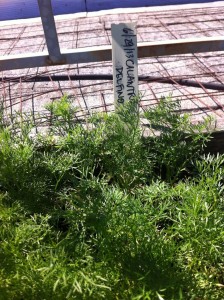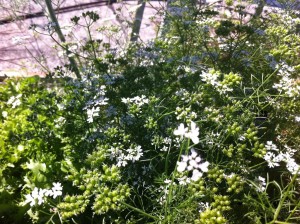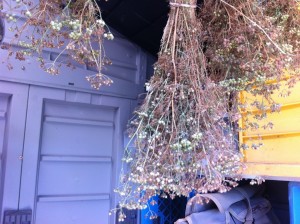It’s that wild and whacky time of the year in the garden when certain characters, like the cilantro I’m profiling here, are not just doing double duty, not just a triumvirate of power in the garden, but a veritable quadrilateral of usefulness to us on the rooftop and down below in the kitchen.
First let’s start with the cilantro everyone knows and loves:
At this point you’re like, “Whoa, this guy’s supposed to know something about gardening, but he just posted a picture of carrot tops and called it cilantro. Everybody knows that cilantro has flat, fan-shaped leaves.” And then I’d have to respond to that voice in your head by saying, “Yo, armchair gardener, at least read the little tag in the picture. It’s Delfino cilantro, the “Delfino” standing for fine, which refers not only to the taste but also the shape of the leaves – fine and fingery. OK?”
Alrighty, then, now that we have that point clarified, I can begin in earnest by saying that our first use of cilantro is just the common, leafy one most people are familiar with – cut it, chop it, and use it in a variety of dishes. But notice I didn’t say cilantro was doing just one thing for us, nor did I pause at two or three. I said four (that was the quadrilateral part), so buckle up because we’re just getting started here.
Actually it won’t be that long of a ride because I’m going to combine functions 2 and 3 into one photo:
Function 2 is as a feeder of beneficial insects. As a member of the family Umbelliferae, it isn’t surprising that cilantro puts out lots of umbrella-shaped flower heads or umbels, each with a profusion of pure white flowers that the bees and beneficial wasps and flies can’t seem to get enough of. So function 2 is purely for the sake of the garden. Let the stuff flower, which happens easily and naturally after the leafy stage, and it’s like waving a flag to the garden good guys, “Hey, over here, free food!” If the gardener provides the munchies for these guys, they go on, when they’re not drinking nectar, to do other things like pollinate crops and attack bad bugs. But, like anything else in the temporal world, function 2 must give way to something else…and for the sake of convenience let’s call that function 3. The flowers fade, fall away, and then, bless my soul, what have we here? Little green balls!
Function 3, also visible in the picture, is another culinary contribution in this plant’s multi-talents. The green seeds, often decried as a lamentable sign of “bolting” (given that the plant has clearly shifted its energies from leaf production to seed production), are viewed quite differently by chefs. The guys and gals at the Rot collect them and use them as an herb unto themselves, and no less a cooking talent than Mark Bittman extols their use this way (http://markbittman.com/cilantro-growers-unite/) Yes, you’ve got to keep planting a steady supply of cilantro if you want leaves, but don’t freak when they bolt; the “little green balls” are good in the kitchen, too! (They need a name, something catchier than cilantro berries. Ideas, anyone?)
Finally, stage 4 comes:
It’s a magical stage, when, like the pupated caterpillar who dons the new name of butterfly, the cilantro, having come through its long, green life, finally browns up and earns the new title of coriander. Now the chefs below might like to get their mitts on this stuff as well, but we gardeners lay claim to this stage for a simple reason. Remember when you had that little inner question about whether I knew what I was talking about because the picture didn’t look like cilantro? Well, its uncommon look is the very reason we plant it, and because it’s different, most seed companies don’t carry it. (Probably because they don’t want to put up with lots of customers calling and complaining, “You sold me a bunch of carrot seeds!”) So in order to have more to plant, we have to save our own seeds. Thus we hang up bunches in the shed, let the green seeds dry to tawny brown, then collect them for planting next season, thus insuring that cilantro (or should I now call it coriander…oh, dear, it is confusing) continues its quadrupedal journey over again. Four cheers for this remarkable plant!



